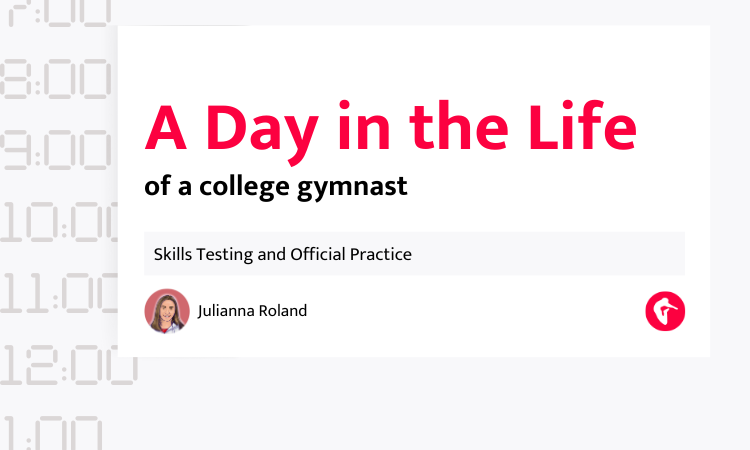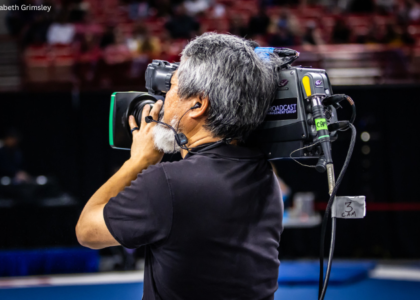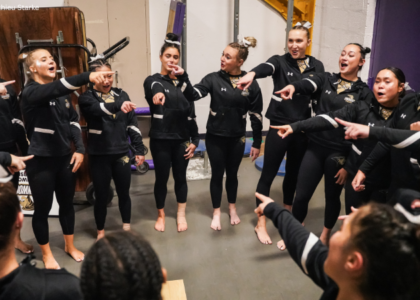It’s time for another behind-the-scenes look at a day in the life of a college gymnast! Last month I wrote about summer practices, moving in, and training for the first time in your new college gym. This time I’m going to walk you through preseason skills testing and official practices.
At this point in the school year, a couple of weeks have passed, you’ve experienced your first football game, and you’ve made it through syllabus week! In the gym, you have had a few weeks to adjust to the equipment and get into the routine of a different style of training.
Before diving into what official practices look like, I’m going to share some quick facts to make sense of what’s coming. Per NCAA rules, in the offseason there are only eight countable hours, which means only eight hours per week can be required by the program. These hours can be practices, lifts, team meetings, etc. Regardless of how these eight hours are broken up, the mandatory training can’t go past this time limit. The key word here is mandatory; many times things would be titled as ‘voluntary’ or ‘captain’s practice’ to comply with the rules, and usually it was expected for you to attend, unless you had, for instance, class at that time. Now that we have made it through a few weeks and official practices have begun, the countable hours per week increase to 20. Like offseason practices, this maximum number of hours can be broken up in any way the coaching staff prefers, but for the athletes, no matter how the time is broken up, this jump from eight to 20 hours is a big change. The amount of time spent in the gym doubles, which means more time for additional reps at practice and an inevitable increase in the intensity of the training. Lifts get harder, time management gets more difficult and, on top of that, you have to keep up with the actual school part of going to college.
Although this may seem overwhelming for people who haven’t experienced it, when I take myself back in time to when I was going through it, I remember feeling really excited! This is the time you start to make friends, you establish a daily routine (even if it might be a little hectic), and you’re finally on the team you have been dreaming of being a part of for years.
Now, let’s get into gymnastics. The biggest change I personally saw in moving from unofficial to official practices was the structure. There is a schedule within each practice, and there are specific assignments for each day. During my time at both the University of Bridgeport and Temple University, these assignments varied depending on the day of the week or what the end of the week goal was. The specific assignments would change – especially as we moved closer to season – but the schedule structure remained relatively the same from the second week of September until November.
What Does a Typical Week of Official Practices Look Like?
The following is what a weekly practice schedule looked like during my time at Bridgeport and Temple:
- Monday – typically a heavier day with more repetitions. At the beginning of the year, it would be skills and parts of routines and we’d get to routines as we got closer to the season. At Temple, we would lift on Mondays whereas at Bridgeport we didn’t weight train, though that has changed for the current team.
- Tuesday – the second heavy day of the week, with just as many numbers as during Monday’s practice. This was normally coupled with bodyweight conditioning in the practice gym and/or a cardio workout.
- Wednesday – this was an off-day at both Temple and Bridgeport. At Temple, we lifted whereas at Bridgeport we would have a lighter, captain’s practice in the morning that was spent working on basics or making up assignments we might not have finished from Monday and Tuesday.
- Thursday – typically the same workload as Monday and Tuesday, meaning a heavier day with bodyweight conditioning in the practice gym combined with cardio.
- Friday – Fridays typically had the most variation over the course of the preseason. During September and the beginning of October, Fridays would be regular practice, but, approaching season, they would turn into mini-intrasquads (something I’ll cover in a future piece).
As you can see, the schedule of a college gymnast is packed.
You not only have to manage a gymnastics schedule but a full course load and the expectation that you will get everything done and done well. On top of this, college training is likely very different from what you’re accustomed to from your club gym training. You might practice at a different time of day (in my own experience, switching to a morning training schedule was a big adjustment), and this might be your first time weightlifting so your body has to get used to that, among so many other changes that you need time to adapt to.
In my first day in the life article, I talked about a summer skill packet and the expectations the coaches had when we returned and started gearing up for season. In my last three years, I was made aware of how important it was to train over the summer and work towards these outlined goals. In the first meeting of the year, the coaches would give us a welcome-back folder; one of the included handouts would always be a breakdown of the benchmark assessments week by week. These benchmarks would be broken down by event, and would be something along the lines of “Athlete is able to complete three vaults in a row on a competition surface.” This is an example of a benchmark that would likely be closer to the start of the competitive season.
A typical week would include one practice that was dedicated to testing the benchmarks. Each person who trained a given event would be tested, and based on whether you met the requirement, combined with how consistent you were individually and in comparison to your teammates, you’d be ranked in what we called a depth chart. Whether there were three people ready to test or the entire team trained the event, the resulting depth chart was posted until the next benchmark when it would change again.
These benchmarks, which later in the season were replaced by intrasquads, were what the week was spent working towards. For example, if the Friday floor benchmark was a full routine, the rest of the week would be centered around preparing for it. The week leading up to that benchmark would consist of: Mondays, tumbling on a soft surface with cardio; Tuesdays; passes on the regular floor; Thursdays, tumbling/problem areas and cardio; which would all build to set us up for Friday.
Skills Testing
Undoubtedly, the biggest change moving from unofficial to official practices is the change in structure. Official practices normally begin around the second or third week of September, and with this came skills testing. Anyone who has ever gone through skills testing knows there is a lot to unpack. While I did not have skills testing at Bridgeport, I did in my last three years at Temple. The way the skills testing day functioned was the same as how benchmarks were tested, but the stakes felt immensely higher. You would complete the assignment one by one and would get three tries. For instance, if part of the beam skills testing was to make three series in a row, you would have those three tries before you had to move to the next portion. However, if you didn’t make it in those three attempts, you would fail that event. To stay on the team, you would have to pass at least two events, unless there was a special circumstance like an injury or being a one-event specialist. For most athletes, the requirement was to pass two events. This might not seem too hard on the surface, especially considering we had done these skills hundreds or thousands of times over the years. But adding to it everything at stake and the pressure to perform, skills testing day was hard, mentally and physically.
It might seem through my description that it was all hard work, and even though it was tough, practices were fun! I would love to go back one more time and dance through practice with my teammates, listen to our throwback playlists, and experience all those little goofy moments you wouldn’t want to share with any other group of people. Preseason was no doubt incredibly difficult, but this was the time when goals were laid out for the season, you got stronger both mentally and physically, and you were able to build strong relationships with your teammates. You all went through it together. During those four days a week, you would be in the gym cheering each other on through the good days and picking each other up on the rough ones. Some of my favorite memories of my five years came from these really hard days and knowing that no matter how difficult the day was, as a result of the work we were putting in, we would all come out stronger together in the end.
Looking back, I have some final thoughts. Was preseason difficult? Absolutely. Would I do it again? Yes (but maybe minus the sprints). Preseason was the time to put in the work and earn the spot you were competing for in lineups. It’s a hard thing to get through preseason with all the long practice days, the conditioning, and managing your stress on top of everything else. But when it comes time for season and you make it to your first competition, you truly feel like all the hard work you put in was worth it.
READ THIS NEXT: A Day in the Life of a College Gymnast: Offseason Training
Article by Julianna Roland





Thank you for this series of articles.
I’ve always wondered what college gymnastics was like behind the scenes.